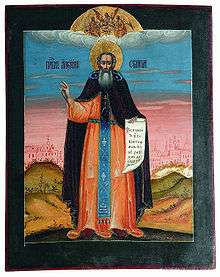Alexander Svirsky
Alexander Svirsky or Alexander of Svir (1448–1533) was an Eastern Orthodox saint, monk and hegumen of Russian Orthodox Church.[1]

Amos (his baptismal name) was born to an ordinary peasant family in the Novgorod Republic, east of Ladoga. At the age of 19, he left home for the Valaam Monastery and spent further time of his life as monk, including some period of total isolation from society.
In 1506, Serapion, Archbishop of Novgorod, appointed him Hegumen of the Trinity monastery, which later became known as Alexander-Svirsky Monastery, at the place of the saint's eremitic life between Roschinsky and Holy lakes, 20 km to the east from Lake Ladoga and 6 km from the Svir River.[2]
The saint became known for his righteous life and contemplative miracles, including the appearances of the Trinity and of Mother Mary with the Holy Child. His day is commemorated on April 17 and August 30[3] according to Eastern Orthodox liturgical calendar.
The relics of the saint were found on April 17 (27), 1641. According to the Vita of the saint, the relics were found incorruptible[4].
On October 22, 1918, the coffin with the relics of Alexander Svirsky was opened. In a cast reliquary weighing over 40 pounds of silver, instead of the imperishable relics of Alexander Svirsky, a wax doll was claimed according to the Soviet reports.[5][6][7]. The testimony of the monks present, as well as a later soviet commission under the direction of Grigory Zinoviev, demonstrated that they found a human body instead of a wax figure.[8][9][10]
References
- "Venerable Alexander the Abbot of Svir". oca.org. Retrieved March 13, 2018.
- (in Russian) Web-site of Alexander-Svirsky monastery
- (in Russian) Orthodox church calendar, "Pravoslavie" web-site
- Александр Свирский, преподобный — прославление // Смирнов С. И. Жития русских святых.
- Кашеваров А. Н. Церковь и власть: Русская Православная Церковь в первые годы Советской власти. — М.: Изд-во СПбГТУ, 1999. — С. 222.
- Отчёт VIII-го Отдела Народного Комиссариата Юстиции Съезду Советов // Революция и церковь : журнал. — № 9—12. — 1920. — С. 70—82.
- Гидулянов, Павел Васильевич. / Отделение церкви от государства в С.С.С.Р. : полный сборник декретов, ведомственных распоряжений и определений Верхсуда Р.С.Ф.С.Р. и других советских социалистических республик: У.С.С.Р., Б.С.С.Р., З.С.Ф.С.Р., Узбекской и Туркменской / П. В. Гидулянов ; под ред. П. А. Красикова. - Изд. 3-е, вновь переработанное и дополненное узаконениями и распоряжениями по 15 мая 1926 г. - Москва : Юридическое издательство, 1926 (Типография МКХ им. Ф. Я. Лаврова). - II, 712 с. / С. 66
- S.A. Smith, "Bones of Contention: Bolsheviks and the Struggle against Relics 1918–1930." Past & Present Vol. 204: 1, (2009): 156-57
- МИХАИЛ ШКАРОВСКИЙ. АНТИРЕЛИГИОЗНАЯ КАМПАНИЯ ИЗЪЯТИЯ МОЩЕЙ В СОВЕТСКОЙ РОССИИ
- For documents, see Милякова Л.: Отделение Церкви от государства и школы от Церкви в Советской России. Октябрь 1917-1918 г. Сборник документов. M., 2016, pp. 456-60.